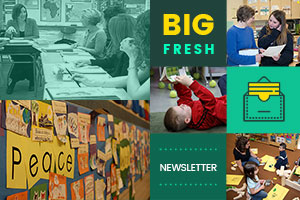You have to trust someone before you can have rituals with them.
Rachel Klein
I am observing in Gigi McAllister’s fourth-grade classroom early in the year. Hannah and Cara are special guests for morning meeting – girls from a fifth-grade class who have come to teach Gigi’s students the secret handshake.
Gigi describes how a few students in last year’s class developed the handshake on their own and taught it to everyone in the class. The handshake was something kids did daily at random times. It is a quick but elaborate mix of fist bumps, high-fives, low-fives, and jellyfishes.
Gigi explains,“This handshake is only for students who have been in this class. Just think – someday when you are in sixth grade and you meet up with one of my students, you can share the handshake. Heck, in 40 years you might run into someone in Walmart who was my student too, and you can know for sure when you do the handshake.”
There is much laughter and concentration as students move through the meeting area, testing and perfecting the handshake among themselves. The energy and sense of fun is potent. The scene makes me think of what rituals any classroom has, and how few might be unique to that classroom. Yet those are what you’ll remember in 40 years when you are in the local grocery store reminiscing about a favorite teacher or class.
Teachers are famous for borrowing freely (and sharing generously) their best new ideas. Every class includes so many routines learned from others. There is not much that is uniquely ours. Yet those quirky rituals are what are remembered most fondly, not the routines students experience year after year. What’s the “secret handshake” in your room? What will students be carrying away that they remember as uniquely yours 40 years from now?
This week we look at how to foster book love in classrooms. Plus more as always — enjoy!
Brenda Power
Founder, Choice Literacy
Free for All
[For sneak peeks at our upcoming features, quotes and extra links, follow Choice Literacy on Twitter: @ChoiceLiteracy or Facebook: http://www.facebook.com/ChoiceLiteracy or Pinterest: http://pinterest.com/choiceliteracy/]
In Speed Dating Books, Carly Ullmer shares a fun activity for introducing teens to new books and each other as readers, capitalizing on their interests:
http://www.choiceliteracy.com/articles-detail-view.php?id=2266
Katie Doherty and Ruth Shagoury create a book lovers’ quilt as a fun way to launch (or close) the year and discover the best-loved books of students from previous years. This project can be adapted for any age level:
http://www.choiceliteracy.com/articles-detail-view.php?id=509
Katherine Sokolowski has advice from students for improving book talks:
http://nerdybookclub.wordpress.com/2016/11/18/book-talks-by-katherine-sokolowski/
Penny Kittle created the Book Love Foundation to get beloved texts in the hands of students. It’s a great charity to keep in mind during this season of generosity and giving thanks:
For Members Only
In Fostering a Culture of Book Love, Tara Smith shares some of her favorite online resources for keeping up with new books, as well as organizing tips for classroom libraries:
http://www.choiceliteracy.com/articles-detail-view.php?id=2642
Shari Frost explains how teachers can use paired texts to help young readers build their skills, starting with books they already know and love:
http://www.choiceliteracy.com/articles-detail-view.php?id=2585
Shirl McPhillips says goodbye to autumn and explores the power of haiku in Life in a Single Breath:
http://www.choiceliteracy.com/articles-detail-view.php?id=2653
Book talks are a great way to foster book love. Christy Rush-Levine piques interest in Boy21 among her seventh graders:
http://www.choiceliteracy.com/articles-detail-view.php?id=2492
In an encore video, Katie Doherty meets with her sixth-grade students who will be sharing their book recommendations with the class, coaching them about how to hold the interest of their classmates:
http://www.choiceliteracy.com/articles-detail-view.php?id=248
That’s all for this week!



